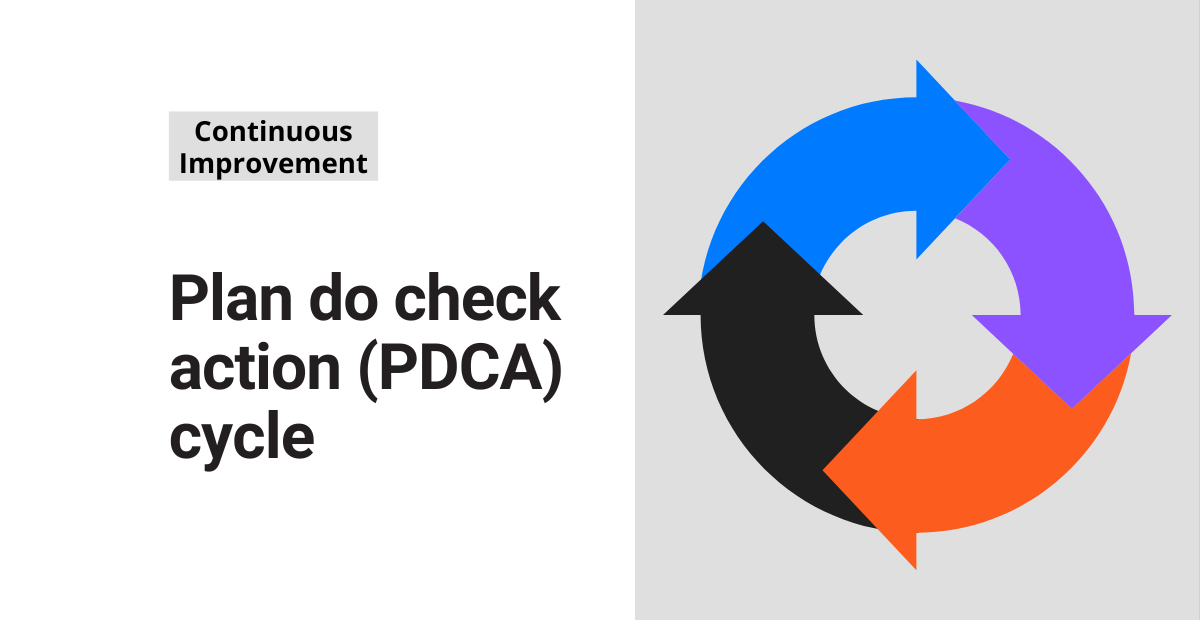A methodical approach to any sort of process improvement is essential for a successful outcome. The “plan do check action” (PDCA) framework gives businesses the structure to tackle goals in all areas of the business, from finance to safety. Therefore, by ensuring you cover each step in sequence, you align efforts with the plan do check action cycle for optimal results.
Free template!
This PDCA Excel template will walk you through the cycle for an effective review. Consider how well it aligns with each segment of the plan, do, check, action process.
What is the PDCA (Plan Do Check Action) cycle?
The PDCA cycle is a model for implementing continuous improvement on products, processes, or services. It is a variation of a process created by Dr. W. Edwards Deming, a pioneer of modern process improvement.
Dr. Deming is most well-known for helping Japanese manufacturers revolutionize their processes in the 1950s, a contribution that allowed Japan to thrive following the aftermath of World War II. He called his original framework the “PDSA cycle,” which included four steps: plan, do, study, act.
The goal of this model is to pursue the most optimal version of a process change. It’s built on the understanding that continuous evaluation and reiteration is needed for long-term success.
Over time, other contributors in the continuous improvement field revised the third stage to “check,” instead of “study.” This shifted the focus from studying theories about operations management to checking the success of a plan. It’s a testament to the evolution of plan do check action methodologies over time.
Learn about each step in the PDCA cycle below.
Plan
The plan step starts with choosing an objective you want to accomplish. For instance, this might include:
- Reducing quality defects
- Increasing production rates
- Making a process safer
- Lowering material costs
Once you’ve defined your goal, you create a plan for how you want to achieve it. In particular, embedding the principles of plan do check action into your strategy ensures thorough preparedness.
Do
The second stage, “do,” involves putting your plan into play, taking the different steps you’ve outlined. Examples of activities in this stage include:
- Training workers in a new way
- Reorganizing a process
- Implementing a new safety measure
- Finding a new supplier or material to use
Only after this stage can you start collecting data and determining whether your plan works. Thus, the do phase is as crucial in the plan do check action process as planning itself.
Check
In this check stage, you review the results of your plan implementation and look for both successes and failures. Also, note that type of information you review will depend on the manner of your goal. For instance, here are a few examples of data you might look at:
- Defects per million opportunities (DPMO)
- Production rates
- Total recordable incident rate (TRIR)
- Total cost
You may find that certain areas of your plan succeed, and others fail, leading to the last stage of the PDCA cycle.
Action
The last stage, “act,” involves using your insights to make the next decision and act on it. Moreover, sometimes this stage takes you back to the drawing board, revising your plan to work towards the same initial goal. In particular, here are some additional actions you might take:
- Implementing a new process sitewide
- Expanding a change to different locations
- Scrapping a proposed safety measure
- Switching material suppliers
This step closes the PDCA cycle. If you go back to the planning stage, make sure you follow through on the steps in order again, as this alignment is pivotal to plan do check action success.
What are the benefits of Plan Do Check Action?
The biggest benefit of the plan, do, check, action cycle is that it provides the structure needed to ensure a change actually improves the business. Moreover, applying plan do check action principles helps synchronize efforts across departments effectively.
Oftentimes, people within an organization make modifications based on their personal theories but not backed by hard data. Over time, this can have a net negative impact by weakening process efficiency, increasing costs, decreasing quality, and more.
When you follow the PDCA cycle to make changes, however, you’re guaranteed to review whether the change is effective. This ensures that you don’t end up with a random assortment of one-off modifications made by multiple people/departments. Instead, your processes, products, and services are well thought-out, creating a better outcome for both employees and customers.





